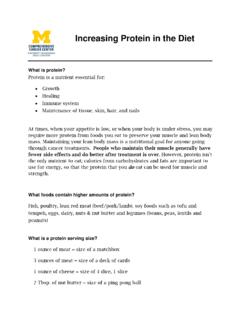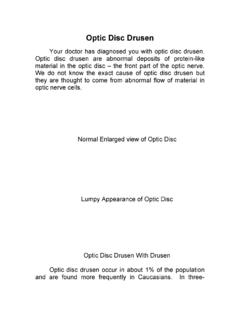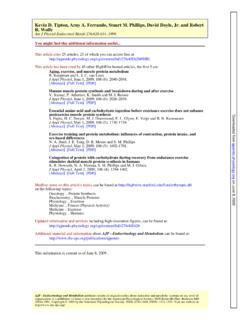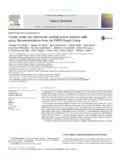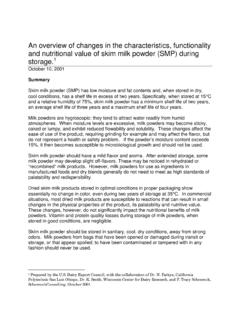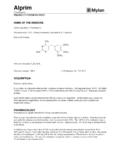Transcription of The U.S. Biosimilars Market
1 Threats and OpportunitiesThe Biosimilars MarketDe a n & Co m p a n ySt r a t e g y Co nSu l t a n tSli f e SCi e nCeSDean & Company is a strategy consulting firm with a unique mix of both traditional business strategy development and a range of investing advisory work; our clients include large corporations, technology start-ups, and private equity funds. We work with senior executives to dramatically and sustainably improve their company s performance, often in situations where they are facing new, complex, and unstructured problems or opportunities.
2 Our fact-based, analytical, and hands-on approach, combined with our commitment to create actionable solutions and to work with our clients to see them through implementation, provides a compelling and unique value proposition. The Biosimilars Market1 The Biosimilars MarketThreats and OpportunitiesTh e r e g u l aT o r y, c o m m e r c i a l, a n d T e c h n i c a l f a cT o r s T h aT w i l l s h a p e T h e f uT u r e o f T h e u .s . b i o s i m i l a r m a r k eTThere are a number of factors that will determine the future of the Biosimilars Market in the The first and most significant factor centers around the approval and regulatory framework in which biosimilar developers will need to work.
3 Policies towards While biosimilar guidelines were approved in the EU in 2005, and a number of products are now on the Market there, Biosimilars are still relatively nonexistent in the single largest biologics Market the United States. To date, only one biosimilar Sandoz automatic substitution, adoption and promotion of Biosimilars by third party payers, and the resolution of safety and quality concerns will have an enormous impact on the potential uptake of Biosimilars within the Market . Finally, the economic and technical Omnitrope has been approved for use in the Omnitrope gained approval through the FDA s 505(b)(2) abbreviated pathway for follow-on protein products.
4 This pathway, however, has proved problematic. Under the 505(b)(2) pathway, feasibility of continued biosimilar development and manufacturing will determine the number and types of players who enter, the set of branded biologics which can be targeted, and the overall revenue and profit potential of the relies on the previous finding of safety and effectiveness for the compound on which the follow-on protein is based. This process is predicated upon the original compound and the follow-on protein being sufficiently similar to be considered the same Over the past 20 years, the emergence of biotechnology products has revolutionized the treatment landscape in a number of therapeutic areas.
5 By developing products based on the human body s own endogenous biological processes, biotech companies have been able to create products with therapeutic potential previously unattainable through traditional small molecule drug development. Now the expiration of the patents protecting these biopharmaceuticals has opened the door to the creation of Biosimilars the biologic equivalent of generic drugs. Beginning in 2014, the projected sales of biologics going off patent in the will exceed those of conventional, small molecule drugs. With multiple biosimilar products on the Market in the EU and discussion in the halls of Congress over the regulation of Biosimilars in the , the biosimilar Market is at a critical point in its development.
6 While its potential is huge, a number of critical factors stand to determine, in the near future, just how much of that potential will be realized. As events continue to unfold, both biotech companies and their biosimilar developing rivals need to determine how to best position themselves to respond to the opportunities and threats that these developments of a regulatory framework for approval within the r a t e g y Co nS u l t a n tSDe a n & Co m p a n yThe Biosimilars Market22product pharmaceutically. Given the complex nature of protein products and the manufacturing processes that produce them, it is no wonder that debate exists about how well this protocol applies to biologics and therefore how much additional and original data must be provided to demonstrate the case of Omnitrope, Sandoz relied on the data submitted for the prior approval of Pfizer s Genotropin.
7 In addition, they provided clinical data in support of Omnitrope s pharmacokinetic, pharmacodynamic, physiochemical, and bioavailability similarity to Genotropin, as well as new pharmacology, toxicology, and safety data specific to Omnitrope. Although the documentation was not as extensive as would be required for a new drug, it still represented a significant investment of time and resources by Sandoz. Even with such extensive documentation, Omnitrope s approval only came after years of consultation and a lawsuit between Sandoz and the FDA. Since its approval, no additional Biosimilars have been submitted to the FDA, as the 505(b)(2) approval pathway is complex and limiting, and the FDA has yet to issue a biosimilar specific protocol for future order for the biosimilar Market to emerge in the , a new regulatory pathway for the approval of follow-on biologics will need to be developed and implemented.
8 To that end, Congress has been working towards passing legislation to explicitly provide a process for FDA approval of Biosimilars , though progress has been slow and contentious. Given the tone of the Obama administration and the emphasis on healthcare reform, it seems inevitable that a regulatory framework will be implemented in the near future. The only question that remains is how much it will favor, or impede, the approval of of the key issues at stake are the Market exclusivity period for branded biologics and the use of previous clinical data in biosimilar approval.
9 In July 2009, the Senate health committee voted TimelineKey Events2005 October 2005 EMEA adopts biosimilar approval guidelinesApril 2006 Approval of Omnitrope and ValtropinMay 2006 FDA approves Omnitrope following lawsuit filed by SandozAugust 2007 Approval of Binocrit and AbseamedJuly 2009 Senate health committee votes in favor of 12-year biotech exclusivity periodApproval of Ratiograstim, Tevagrastim, and BiograstimSeptember 2008 December 2007 Approval of Retacrit and SilapoFebruary 2009 Approval of ZarzioThe Biosimilars Market3 Prior to 1970, legislation prohibited pharmacists from substituting generic drugs for prescriptions written for brand name drugs.
10 It wasn t until the law was repealed and pharmacists were allowed to freely dispense generics that generic drugs gained popularity and the Market grew. Now, much like the nascent generics Market of 40 years ago, the Biosimilars Market stands to be significantly impacted by substitution as the complexity of Biosimilars relative to generics has impacted their regulatory approval, it seems likely that this complexity could prevent, at least in the near term, pharmacy substitution as well. In Europe, several countries have already enacted laws banning the automatic substitution of Biosimilars .

